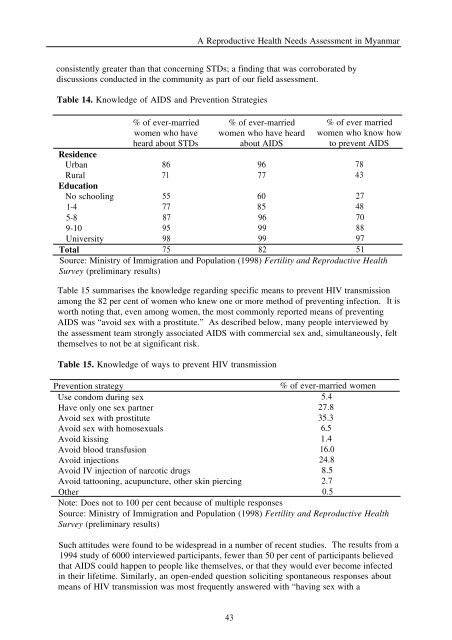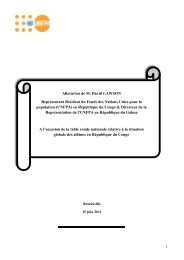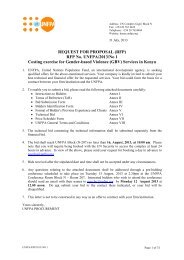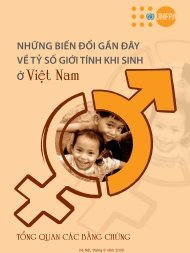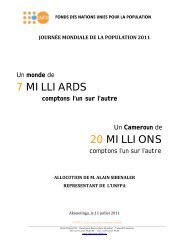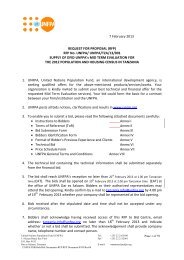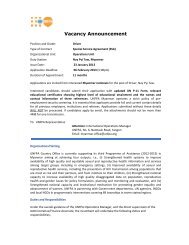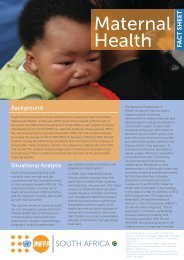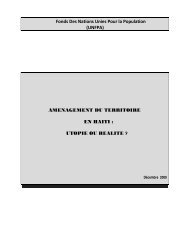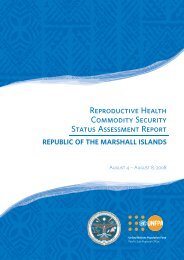A reproductive health needs assessment in Myanmar
A reproductive health needs assessment in Myanmar
A reproductive health needs assessment in Myanmar
You also want an ePaper? Increase the reach of your titles
YUMPU automatically turns print PDFs into web optimized ePapers that Google loves.
A Reproductive Health Needs Assessment <strong>in</strong> <strong>Myanmar</strong><br />
consistently greater than that concern<strong>in</strong>g STDs; a f<strong>in</strong>d<strong>in</strong>g that was corroborated by<br />
discussions conducted <strong>in</strong> the community as part of our field <strong>assessment</strong>.<br />
Table 14. Knowledge of AIDS and Prevention Strategies<br />
% of ever-married % of ever-married % of ever married<br />
women who have women who have heard women who know how<br />
heard about STDs about AIDS to prevent AIDS<br />
Residence<br />
Urban 86 96 78<br />
Rural 71 77 43<br />
Education<br />
No school<strong>in</strong>g 55 60 27<br />
1-4 77 85 48<br />
5-8 87 96 70<br />
9-10 95 99 88<br />
University 98 99 97<br />
Total 75 82 51<br />
Source: M<strong>in</strong>istry of Immigration and Population (1998) Fertility and Reproductive Health<br />
Survey (prelim<strong>in</strong>ary results)<br />
Table 15 summarises the knowledge regard<strong>in</strong>g specific means to prevent HIV transmission<br />
among the 82 per cent of women who knew one or more method of prevent<strong>in</strong>g <strong>in</strong>fection. It is<br />
worth not<strong>in</strong>g that, even among women, the most commonly reported means of prevent<strong>in</strong>g<br />
AIDS was “avoid sex with a prostitute.” As described below, many people <strong>in</strong>terviewed by<br />
the <strong>assessment</strong> team strongly associated AIDS with commercial sex and, simultaneously, felt<br />
themselves to not be at significant risk.<br />
Table 15. Knowledge of ways to prevent HIV transmission<br />
Prevention strategy<br />
% of ever-married women<br />
Use condom dur<strong>in</strong>g sex 5.4<br />
Have only one sex partner 27.8<br />
Avoid sex with prostitute 35.3<br />
Avoid sex with homosexuals 6.5<br />
Avoid kiss<strong>in</strong>g 1.4<br />
Avoid blood transfusion 16.0<br />
Avoid <strong>in</strong>jections 24.8<br />
Avoid IV <strong>in</strong>jection of narcotic drugs 8.5<br />
Avoid tattoon<strong>in</strong>g, acupuncture, other sk<strong>in</strong> pierc<strong>in</strong>g 2.7<br />
Other 0.5<br />
Note: Does not to 100 per cent because of multiple responses<br />
Source: M<strong>in</strong>istry of Immigration and Population (1998) Fertility and Reproductive Health<br />
Survey (prelim<strong>in</strong>ary results)<br />
Such attitudes were found to be widespread <strong>in</strong> a number of recent studies. The results from a<br />
1994 study of 6000 <strong>in</strong>terviewed participants, fewer than 50 per cent of participants believed<br />
that AIDS could happen to people like themselves, or that they would ever become <strong>in</strong>fected<br />
<strong>in</strong> their lifetime. Similarly, an open-ended question solicit<strong>in</strong>g spontaneous responses about<br />
means of HIV transmission was most frequently answered with “hav<strong>in</strong>g sex with a<br />
43


